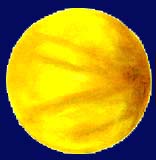Venus
- Diameter is 7,521 miles (12,104 km), which is about 95% the diameter of Earth.
- Distance from Sun is 67,250,000 miles (108.2 million km).
- Average temperature is 867°F (464°C) --
- Surface temperatures reach at least 900°F (480°C).
- Venus has no moons.
- Rotation takes 243 days, 14 minutes.
- Revolution takes 224.7 days.
- Total solid volume is 86% that of Earth's.
- Mass is 82% that of Earth.
- Density is 5.2 times that of water; about 95% of that of earth.
- Gravity is 91% of that experienced on Earth.
- Venus is inclined 3.5° compared to the earth.
- Rotation is east to west (retrograde) -- opposite all other planets in the solar system.
- Atmospheric pressure is estimated to be about 90 times that at sea level on earth.
- Atmosphere --
- The atmosphere of Venus is comprised mostly of carbon dioxide.
- Venus's triple-layered cloud mantle is about 12.5 miles (20 km) thick:
- Temperatures at the top of this cloud layer are -40°F (-40°C).
- Clouds move around the planet at speeds exceeding 185 mph (300 km/h); complete one circuit every 4 days.
- The upper layer lies at altitudes of 35-40 miles (56-68 km) miles above the planet, and is comprised of droplets of sulphuric acid at concentrations up to 85%.
- The middle layer is at altitudes of 32-35 miles (51-56 km), and is comprised of sulfuric acid droplets and a mixture of large and medium-sized particles.
- The lower layer is at altitudes 30-32 miles (48-50 km), and is comprised almost totally of large particles which are possibly sulfur in the free state and may give the planet its yellowish color.
- Temperatures at the base of this cloud layer are a boiling 212°F (100°C).
- The atmosphere below the cloud layer may be divided into two zones:
- From the planet to an altitude of 10 miles (16 km), the atmosphere is relatively clear of clouds.
- While the Venusian clouds speed around the planet at higher altitudes, the surface of the planet only experiences breezes at around 4 mph (6 km/h).
- Above 10 miles to just below the layer of clouds, a region 20 miles (32 km) thick is misty.
- Beyond the upper layer of clouds, another misty layer atmosphere extends for another 56 miles (90 km).
- At an elevation of 62 miles (100 km) the temperatures is a cold -130°F (-90°C).
- Venus's discernible atmosphere extends as much as 155 miles (250 km) above the surface of the planet, where the temperature is 86¯F (30¯C).
- The Venusian ionosphere reaches to about 250 miles (400 km) from the planet's surface.
- Numberous space probes have been launched to study Venus; some highlights are:
- The Soviets launched a series of probes starting in 1961 with Venera 1, continuing through the Venera series to Venera 14 around 20 years later.
- Venera 2 was the first to reach another planet by hitting Venus on March 1, 1966.
- Americans launched Mariner 2 toward Venus on August 26, 1962, followed by Mariner 5 (1967) and Mariner 10 (1973).
- In 1984, Soviets launched Vega 1 and 2, with international cooperation.
- It is the brightest non-luminary in the night sky.
- Venus is an average of 25,700,000 miles (41,400,000 km) closer to the Sun than earth.
- Venus is the hottest planet -- hotter than Mercury, which is closer to the Sun -- because the large amount of carbon dioxide in its atmostphere traps heat.
- Radio-wave emissions from Venus, discovered in 1956, are associated with its high heat level.
- Due to its albedo and the proximity of its orbit, Venus is probably the most recognizable of the visible planets.
- Halfway between its greatest elongation (47°) and inferior conjunction, the magnitude of Venus is at its greatest, up to -4.7.
- The next pair of transits of Venus will be on June 8, 2004 and June 6, 2012.
|




